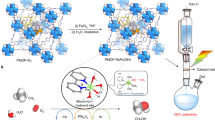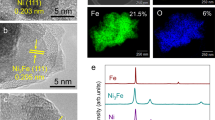Abstract
The Fe protein of nitrogenase contains a redox active [Fe4S4] cluster that plays a key role in electron transfer and substrate reduction. Here we show that the Fe protein of Methanosarcina acetivorans can reduce CO2 and CO to hydrocarbons under ambient conditions. Further, we demonstrate that this reactivity is inherent to [Fe4S4] clusters, showing the ability of a synthetic [Fe4S4] compound to catalyse the same ambient reaction in solutions. Theoretical calculations suggest a reaction mechanism involving an aldehyde-like intermediate that gives rise to hydrocarbon products upon proton-coupled electron transfer and concomitant removal of water molecules. These results provide a framework for mechanistic investigations of FeS-based activation and reduction of CO2 and CO while facilitating potential development of FeS catalysts capable of ambient conversion of CO2 and CO into fuel products.
This is a preview of subscription content, access via your institution
Access options
Access Nature and 54 other Nature Portfolio journals
Get Nature+, our best-value online-access subscription
$29.99 / 30 days
cancel any time
Subscribe to this journal
Receive 12 digital issues and online access to articles
$119.00 per year
only $9.92 per issue
Buy this article
- Purchase on Springer Link
- Instant access to full article PDF
Prices may be subject to local taxes which are calculated during checkout





Similar content being viewed by others
References
Burgess, B. K. & Lowe, D. J. Mechanism of molybdenum nitrogenase. Chem. Rev. 96, 2983–3012 (1996).
Schilter, D., Camara, J. M., Huynh, M. T., Hammes-Schiffer, S. & Rauchfuss, T. B. Hydrogenase enzymes and their synthetic models: the role of metal hydrides. Chem. Rev. 116, 8693–8749 (2016).
Mühlenhoff, U. et al. Compartmentalization of iron between mitochondria and the cytosol and its regulation. Eur. J. Cell Biol. 94, 292–308 (2015).
O’Brien, E. et al. The [4Fe4S] cluster of human DNA primase functions as a redox switch using DNA charge transport. Science 355, 813 (2017).
Mettert, E. L. & Kiley, P. J. Fe-S proteins that regulate gene expression. Biochim. Biophys. Acta 1853, 1284–1293 (2015).
Rees, D. C. et al. Structural basis of biological nitrogen fixation. Phil. Trans. A 363, 971–984 (2005).
Rees, D. C. & Howard, J. B. The interface between the biological and inorganic worlds: iron-sulfur metalloclusters. Science 300, 929–931 (2003).
Georgiadis, M. M. et al. Crystallographic structure of the nitrogenase iron protein from Azotobacter vinelandii. Science 257, 1653–1659 (1992).
Rebelein, J. G., Stiebritz, M. T., Lee, C. C. & Hu, Y. Activation and reduction of carbon dioxide by nitrogenase iron proteins. Nat. Chem. Biol. 13, 147–149 (2017).
Rofer-DePoorter, C. K. A comprehensive mechanism for the Fischer-Tropsch synthesis. Chem. Rev. 81, 447–474 (1981).
Hiller, C. J., Stiebritz, M. T., Lee, C. C., Liedtke, J. & Hu, Y. Tuning electron flux through nitrogenase with methanogen iron protein homologues. Chemistry 23, 16152–16156 (2017).
Vincent, K. A. et al. Instantaneous, stoichiometric generation of powerfully reducing states of protein active sites using Eu(II) and polyaminocarboxylate ligands. Chem. Commun. 20, 2590–2591 (2003).
Jeoung, J. H., Fesseler, J., Goetzl, S. & Dobbek, H. Carbon monoxide. Toxic gas and fuel for anaerobes and aerobes: carbon monoxide dehydrogenases. Met. Ions Life Sci. 14, 37–69 (2014).
Kung, Y. & Drennan, C. L. A role for nickel-iron cofactors in biological carbon monoxide and carbon dioxide utilization. Curr. Opin. Chem. Biol. 15, 276–283 (2011).
Can, M., Armstrong, F. A. & Ragsdale, S. W. Structure, function, and mechanism of the nickel metalloenzymes, CO dehydrogenase, and acetyl-CoA synthase. Chem. Rev. 114, 4149–4174 (2014).
Mayhew, S. G. The redox potential of dithionite and SO2 − from equilibrium reactions with flavodoxins, methyl viologen and hydrogen plus hydrogenase. Eur. J. Biochem. 85, 535–547 (1978).
Averill, B. A., Herskovitz, T., Holm, R. H. & Ibers, J. A. Synthetic analogs of the active sites of iron-sulfur proteins. II. Synthesis and structure of the tetra(mercapto-μ3-sulfido-iron) clusters, (Fe4S4(SR)4)2−. J. Am. Chem. Soc. 95, 3523–3534 (1973).
Barclay, J. E., Davies, S. C., Evans, D. J., Hughes, D. I. & Longhurst, S. Lattice effects in the Mössbauer spectra of salts of [Fe4S4{S(CH2) n OH}4]2−. Crystal structures of [PPh4]2[Fe4S4{S(CH2)nOH}4] (n = 2, 3 and 4). Inorg. Chim. Acta 291, 101–108 (1999).
Sickerman, N. S., Hu, Y. & Ribbe, M. W. Activation of CO2 by vanadium nitrogenase. Chem. Asian J. 12, 1985–1996 (2017).
Dance, I. How does vanadium nitrogenase reduce CO to hydrocarbons? Dalton Trans. 40, 5516–5527 (2011).
Proskurowski, G. et al. Abiogenic hydrocarbon production at lost city hydrothermal field. Science 319, 604–607 (2008).
McDermott, J. M., Seewald, J. S., German, C. R. & Sylva, S. P. Pathways for abiotic organic synthesis at submarine hydrothermal fields. Proc. Natl Acad. Sci. USA 112, 7668–7672 (2015).
Novikov, Y. & Copley, S. D. Reactivity landscape of pyruvate under simulated hydrothermal vent conditions. Proc. Natl Acad. Sci. USA 110, 13283–13288 (2013).
Roldan, A. et al. Bio-inspired CO2 conversion by iron sulfide catalysts under sustainable conditions. Chem. Commun. 51, 7501–7504 (2015).
Huber, C. & Wächtershäuser, G. Activated acetic acid by carbon fixation on (Fe,Ni)S under primordial conditions. Science 276, 245–247 (1997).
Scheidler, C., Sobotta, J., Eisenreich, W., Wächtershäuser, G. & Huber, C. Unsaturated C3,5,7,9-monocarboxylic acids by aqueous, one-pot carbon fixation: possible relevance for the origin of life. Sci. Rep. 6, 27595 (2016).
Huber, C. & Wächtershäuser, G. Alpha-hydroxy and alpha-amino acids under possible Hadean, volcanic origin-of-life conditions. Science 314, 630–632 (2006).
Huber, C. & Wächtershäuser, G. Peptides by activation of amino acids with CO on (Ni,Fe)Ssurfaces: implications for the origin of life. Science 281, 670–672 (1998).
Roslev, P., Iversen, N. & Henriksen, K. Oxidation and assimilation of atmospheric methane by soil methane oxidizers. Appl. Environ. Microbiol. 63, 874–880 (1997).
Coleman, N. V. & Spain, J. C. Distribution of the coenzyme M pathway of epoxide metabolism among ethene- and vinyl chloride-degrading Mycobacterium strains. Appl. Environ. Microbiol. 69, 6041–6046 (2003).
Saba, S. et al. A simple and efficient one-step protocol for the preparation of alkyl-substituted ammonium tetrafluoroborate and hexafluorophosphate salts. J. Fluor. Chem. 153, 168–171 (2013).
Evans, W. J. et al. Solution synthesis and crystallographic characterization of the divalent organosamarium complexes (C5Me5)2Sm(THF)2 and [(C5Me5)Sm(µ-I)(THF)2]2. J. Am. Chem. Soc. 107, 941–946 (1985).
Lee, C. C., Hu, Y. & Ribbe, M. W. Stepwise formation of P-cluster in nitrogenase MoFe protein. Proc. Natl Acad. Sci. USA 106, 9209–9214 (2009).
Hu, Y., Fay, A. W. & Ribbe, M. W. Identification of a nitrogenase FeMo cofactor precursor on NifEN complex. Proc. Natl Acad. Sci. USA 102, 3236–3241 (2005).
Lee, C. C., Hu, Y. & Ribbe, M. W. Vanadium nitrogenase reduces CO. Science 329, 642 (2010).
Hu, Y., Lee, C. C. & Ribbe, M. W. Extending the carbon chain: hydrocarbon formation catalyzed by vanadium/molybdenum nitrogenases. Science 333, 753–755 (2011).
Ahrichs, R., Bär, M., Häser, M., Horn, H. & Kömel, C. Electronic structure calculations on workstation computers: the program system Turbomole. Chem. Phys. Lett. 162, 165–169 (1989).
Schaftenaar, G. & Noordik, J. H. Molden: a pre- and post-processing program for molecular and electronic structures. J. Comput. Aided Mol. Des. 14, 123–134 (2000).
Klamt, A. & Schüürmann, G. COSMO: a new approach to dielectric screening in solvents with explicit expressions for the screening energy and its gradient. J. Chem. Soc. Perkin Trans. 2, 799–805 (1993).
Tao, J., Perdew, J. P., Staroverov, V. N. & Scuseria, G. E. Climbing the density functional ladder: Nonempirical meta-generalized gradient approximation designed for molecules and solids. Phys. Rev. Lett. 91, 146401 (2003).
Schäfer, A., Huber, C. & Ahlrichs, R. Fully optimized contracted Gaussian basis sets of triple zeta valence quality for atoms Li to Kr. J. Chem. Phys. 100, 5829–5836 (1994).
Weigend, F. & Ahlrichs, R. Balanced basis sets of split valence, triple zeta valence and quadruple zeta valence quality for H to Rn: Design and assessment of accuracy. Phys. Chem. Chem. Phys. 7, 3297–3305 (2005).
Eichkorn, K., Weigend, F., Treutler, O. & Ahlrichs, R. Auxiliary basis sets for main row atoms and transition metals and their use to approximate Coulomb potentials. Theor. Chem. Acc. 97, 119–124 (1997).
Weigend, F. Accurate Coulomb-fitting basis sets for H to Rn. Phys. Chem. Chem. Phys. 8, 1057–1065 (2006).
Noodleman, J. Valence bond description of antiferromagnetic coupling in transition metal dimers. J. Chem. Phys. 74, 5737–5743 (1981).
Noodleman, J., Post, D. & Baerends, E. Symmetry breaking and ionization from symmetry equivalent inner shells and lone pairs in Xα theory. Chem. Phys. 64, 159–166 (1982).
Noodleman, J., Peng, C. Y., Case, D. A. & Mouesca, J. M. Orbital interactions, electron delocalization and spin coupling in iron-sulfur clusters. Coord. Chem. 144, 199–244 (1995).
Noodleman, L., Han, Du,W. G., Fee, J. A., Götz, A. W. & Walker, R. C. Linking chemical electron-proton transfer to proton pumping in cytochrome c oxidase: broken-symmetry DFT exploration of intermediates along the catalytic reaction pathway of the iron-copper dinuclear complex. Inorg. Chem. 53, 6458–6472 (2014).
Torres, R. A., Lovell, T., Noodleman, L. & Case, D. A. Density functional and reduction potential calculations of Fe4S4 clusters. J. Am. Chem. Soc. 125, 1923–1936 (2003).
Tissandier, M. D. et al. The proton’s absolute aqueous enthalpy and Gibbs free energy of solvation from cluster-ion solvation data. J. Phys. Chem. A 102, 7787–7794 (1998).
Acknowledgements
We thank M. Ribbe (UCI) for helpful discussions. This work was supported by NSF CAREER grant CHE-1651398 (to Y.H.), a grant-in-aid for scientific research (16H04116) from the Japanese Ministry of Education, Culture, Sports, Science and Technology (MEXT), Hori Sciences and Arts Foundation grant, and Takeda Science Foundation grant (to Y.O.).
Author information
Authors and Affiliations
Contributions
Y.H. planned the research, M.T.S., C.J.H., N.S.S., C.C.L., K.T., and Y.O. performed the experiments, and Y.H. prepared the manuscript with suggestions of Y.O.
Corresponding author
Ethics declarations
Competing interests
The authors declare no competing interests.
Additional information
Publisher’s note: Springer Nature remains neutral with regard to jurisdictional claims in published maps and institutional affiliations.
Supplementary information
Supplementary Information
Supplementary Notes 1–3, Supplementary Discussion, Supplementary Figures 1–12, Supplementary References
Rights and permissions
About this article
Cite this article
Stiebritz, M.T., Hiller, C.J., Sickerman, N.S. et al. Ambient conversion of CO2 to hydrocarbons by biogenic and synthetic [Fe4S4] clusters. Nat Catal 1, 444–451 (2018). https://doi.org/10.1038/s41929-018-0079-4
Received:
Accepted:
Published:
Issue Date:
DOI: https://doi.org/10.1038/s41929-018-0079-4
This article is cited by
-
Spontaneous assembly of redox-active iron-sulfur clusters at low concentrations of cysteine
Nature Communications (2021)
-
Residues surrounding the active centre of carbon monoxide dehydrogenase are key in converting CO2 to CO
JBIC Journal of Biological Inorganic Chemistry (2021)



